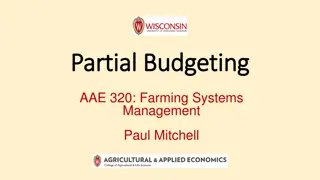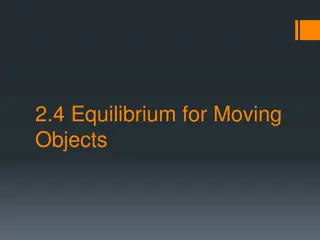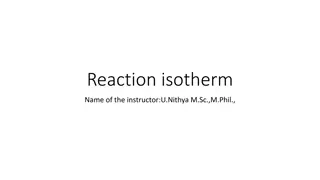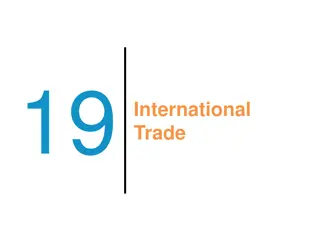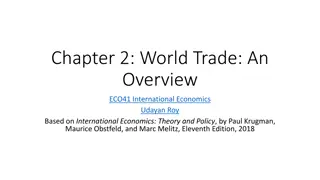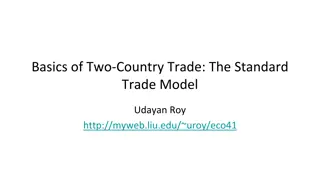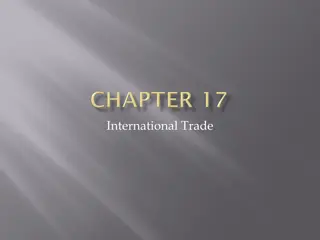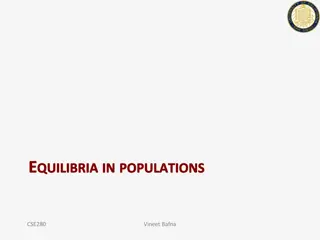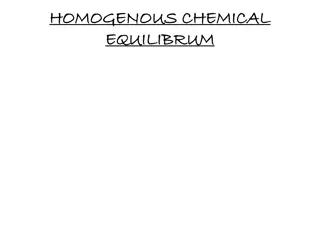Understanding Partial Equilibrium Modeling in International Trade
Exploring the motivation for free trade in a two-country model and the determination of world prices based on supply and demand differentials. The model highlights relative cost advantages for exporting countries and cost disadvantages for importing countries, leading to decisions on export surpluses and import deficits.
Download Presentation

Please find below an Image/Link to download the presentation.
The content on the website is provided AS IS for your information and personal use only. It may not be sold, licensed, or shared on other websites without obtaining consent from the author. Download presentation by click this link. If you encounter any issues during the download, it is possible that the publisher has removed the file from their server.
E N D
Presentation Transcript
Tutorial on Partial Equilibrium Modeling: Motivation for trade The Microeconomics of International Trade ECN230 Roberto J. Garcia School of Economics and Business, NMBU
Motivation for free trade Two country trade model, one good Countries 1 and 2 exist in autarky, closed markets. Market of country 1 is in equilibrium at [P1]* where its quantity demanded equals quantity supplied, QD = QS. Market of country 2 is in equilibrium at [P2]* where its quantity demanded equals quantity supplied, QD = QS. Market of country 1 Market of country 2 Price Price D S D S [P2]* [P1]* Q Q QD=QS QD=QS
Motivation for free trade Pre-trade prices Supply and demand determine prices: [P1]* and [P2]* Supply and demand differences imply: [P1]* [P2]* For trade to occur, there must be a trade price that lies between the existing closed market prices. Market of country 1 Market of country 2 World market Price Price PWorld D S D S [P2]* [P2]* [P1]* [P1]* Q Q QTraded QD=QS QD=QS 3
Motivation for free trade Determination of the world price The price differential is an incentive for trade Country 1 has a lower price, [P1]* < [P2]*, which means it has a relative cost advantage, making it a potential exporter. Country 2 has a higher price, [P2]* > [P1]*, which means it has a relative cost disadvantage, making it a potential importer. For the exporting country, it is necessary to determine the country s willingness to export. This involves solving for the excess supply at all relevant prices. For the importing country, it is necessary to determine the country s willingness to import. This involves solving for the excess demand at all relevant prices. 4
Motivation for free trade Excess supply: (S D) of exporting country The willingness to export to the world market various quantities of the specific good at all relevant prices, i.e., P > [P1]* At [P1]*, there is no exportable surplus because the country is in equilibrium The exportable surplus (S-D) increases as P increases to [P2]* Market of country 1 World market Price PWorld S D ES g g f f [P2]* [P2]* e d e d P'' P'' b c P' b c P' [P1]* a [P1]* a Q 5 QTraded QD=QS
Motivation for free trade Excess demand: (D S) of importing country The willingness to import from the world market various quantities of the specific good at all relevant prices, i.e., P < [P2]* At [P2]*, there is no deficit because the country is in equilibrium The deficit (D-S) increases as P decreases to [P1]* Market of country 2 World market PW Price D S [P2]* h h [P2]* i i j P'' j P'' l k k l P' P' n m m [P1]* n [P1]* ED QTraded Q 6 QD=QS
Motivation for free trade Free trade equilibrium: ES = ED At ES = ED, the quantity exported by country 1 is equal to the quantity imported by country 2, QX= QM= QT. There is only one price, [PW]*, at which the world market is in equilibrium this is the law of one price (LOOP). Conditions: no government intervention, an identical good, competitive markets and no transactions/transport costs. Market of country 1 Market of country 2 World market PW Price Price S D D S ES [P2]* Surplus [PW]* [PW]* [PW]* Deficit [P1]* ED QTraded Q Q QD=QS QD' QS' QS' QD' QD=QS [QT]* = QX = QM
Motivation for free trade Summary Price differentials are an incentive for trade. A cost-competitive country will be a net exporting country in a free trade situation. The move from no trade to free trade increases the equilibrium price, [PW]* > [P1]*, reducing the quantity demanded and increasing the quantity supplied. The higher the world price, the more producers/exporters gain, but the more domestic consumers of the good lose. A high-cost country will be a net importing country in a free trade situation. The move from no trade to free trade decreases the equilibrium price, [PW]* < [P2]*, increasing the quantity demanded and reducing the quantity supplied, causing a deficit. The lower the world price, the more consumers gain because the price of the good decreases, but the more the import- competing sector loses. The optimal amount traded is at [PW]*. 8



